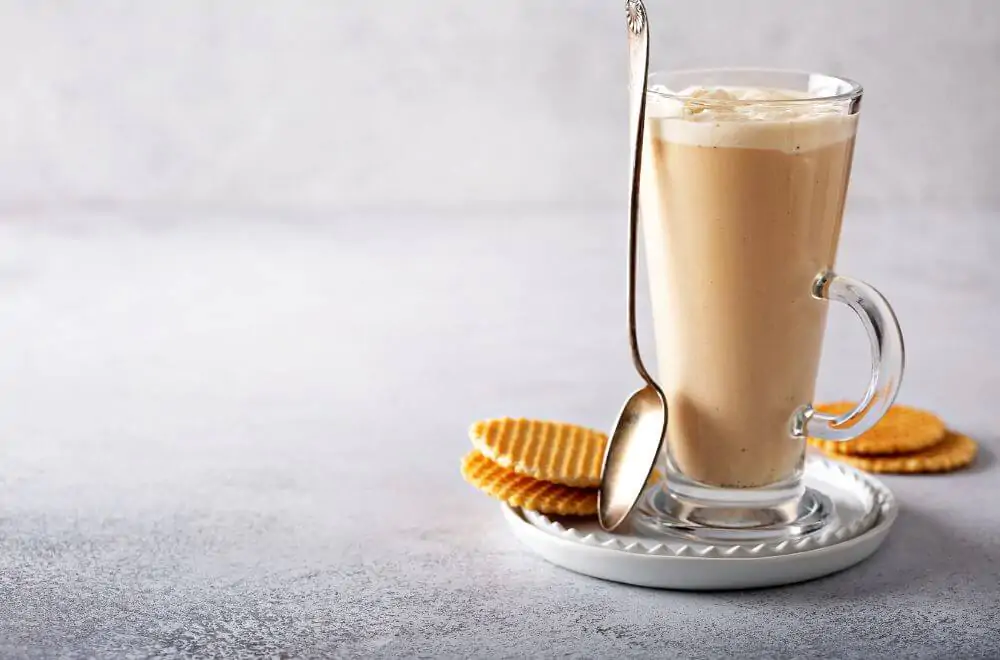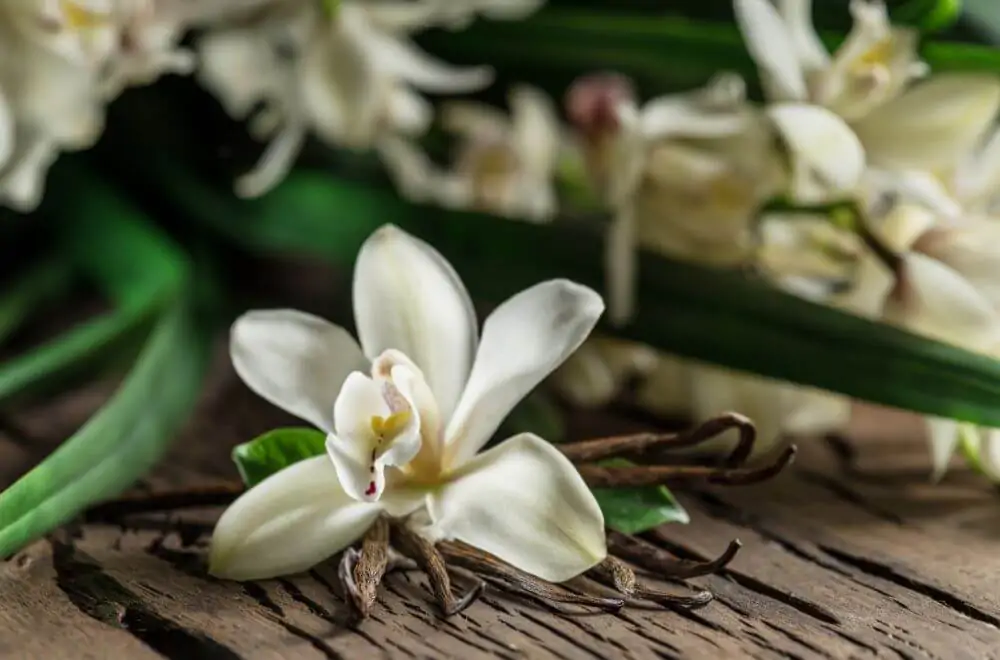Are you confused when you look at the coffee shop menu and wonder, what is French vanilla coffee? This drink uses French vanilla flavoring to enhance the flavor.

While some people like a black cup of coffee, I prefer something with a bit more flavor and sweetness. Typically, I enjoy a nice latte or iced coffee, but I also really like French vanilla coffee. This type of beverage uses French vanilla flavoring, usually in a synthetic version, as opposed to all-natural vanilla.
Once I tried this coffee, I was hooked, both on the hot and iced coffee variations. Here’s everything you need to know about French vanilla coffee.
What Is In French Vanilla Coffee?
French vanilla coffee gets its smooth and creamy taste from French vanilla ice cream. If you’ve ever had that frozen treat before, you know it’s noticeably different from regular vanilla, and it also has a more yellowish color to it.
The secret of French vanilla ice cream is that it uses egg yolks as its base instead of cream or other ingredients. These yolks are what give the ice cream its distinct coloration, and they make the dessert far smoother and easier to eat.
So, when talking about French vanilla coffee, we’re referring to either coffee beans, ground coffee, or brewed coffee with either French vanilla syrup or a specialty vanilla extract. In the case of coffee beans and grounds, the syrup or flavoring is added after the roasting process to ensure it mixes in with the rest of your beverage.
Some coffee shops like Starbucks will add some extra panache to their French vanilla coffee by incorporating other flavors, such as hazelnut syrup or flavored coffee creamer. Overall, extra add-ons make these coffee drinks taste so much sweeter and creamier than they would normally.
A Brief History Of French Vanilla-Flavored Coffee
For us to understand the history of French vanilla coffee, we must dive into the murky and sordid world of vanilla itself. It’s ironic that the term “vanilla” means plain and uninteresting, considering that its story is far from boring.
While we won’t dive into all the intricate details of how vanilla came to be, we know that its origin was in Mexico. The first people to discover vanilla were the Totonacs, who mastered the techniques necessary to grow and cultivate the flower. Interestingly, this tribe rarely used vanilla beans for cooking or eating – instead opting to incorporate them into their religious ceremonies.
Being a tribe in ancient Mexico meant that the Totonacs would eventually come head-to-head with the Aztecs, who swiftly took over their lands. The Aztecs fell in love with vanilla and demanded it as tribute from the Totonacs during their reign.

It was the Aztecs who also created the first version of hot chocolate. They would mix cacao and vanilla into a hot beverage, which they called xocolatl (aka chocolatl). This beverage was also part of religious ceremonies, and it’s said that Aztec emperor Montezuma gave chocolatl to Cortez, who took the recipe, killed the natives, and brought Mexican hot chocolate back to Europe.
In Europe, vanilla quickly spread across the continent as everyone, from royalty to merchants, appreciated the robust and exciting flavor. It wasn’t long before British colonials in America started adopting vanilla, with future president Thomas Jefferson mixing it with his ice cream for a tasty new treat.
During this period, adding vanilla to ice cream and other confections became quite popular. It was also during this era when the “French” style of vanilla ice cream popped up. By using an egg custard base, purveyors generated a bolder and richer dessert, which caught on pretty quickly.
French Vanilla Today
These days, French vanilla syrups and flavorings are commonplace, which is why you can find French vanilla coffee in virtually any coffee shop. Even other places that sell coffee, like gas stations and diners, will keep this flavoring on hand for a more remarkable version of a vanilla latte or espresso.
What is French Vanilla Coffee Compared to Other Coffee Drinks?
Thanks to its decadent and creamy flavor, French vanilla is often compared to other “sweet” coffee drinks, such as lattes, cappuccinos, mochas, and Americanos. So, let’s break down how a cup of French vanilla coffee stacks up against all challengers. You might also find our caramel macchiato vs. vanilla latte guide useful.
Flavor Profile
French vanilla coffee has a light, smooth, and sweet flavor that can’t be replicated. The exact taste of the beverage depends on the source of the vanilla and the roast of the coffee. If you’re using medium roast coffee beans infused with French vanilla flavoring, the results will be relatively subtle.
However, if you add a few pumps of French vanilla syrup to your already-brewed beverage, the taste will be stronger and more noticeable. With other coffee varieties, the flavor comes from the beans and the roasting and brewing process. So, there are more complex and subtle blends, especially compared to the noticeable flavoring of French vanilla coffee.
Coffee Beans
Typically, this flavor works well with medium or light-roast coffee. Almost all forms of coffee sold today use Arabica beans, which are milder and have less acidity than other bean varieties, like Robusta. However, depending on the type of coffee you choose, the beans will have more or less of an impact on the results.
For example, when drinking an espresso, the flavor and caffeine content of the beans comes through really well. This is partly why so many people choose to add creamer or sweetener to espresso to cut down on its bitterness and acidity.
Caffeine Content
As a rule, French vanilla coffee tends to have more caffeine compared to a cappuccino or latte. The reason for the discrepancy is that other coffee blends use milk, creamer, or foam to cut down on the actual brewed liquid present. For example, with a cappuccino, you have to mix equal parts espresso, steamed milk, and foam.
So, with an eight-ounce serving, you’re only getting 2.3 ounces of actual coffee.
By comparison, since you’re using creamer, syrup, or flavor-infused beans, you get more “coffee” for your money, leading to a higher caffeine content. You might also be interested in learning about vanilla chai tea.
Making French Vanilla Coffee At Home
There are three primary ways you can brew French vanilla coffee at home – with syrup, with creamer, or with beans. Here’s a quick rundown of each option and how you may want to brew it.
- Using French vanilla syrup: Since this syrup has a sweet and tangy flavor to it, you want a relatively mild and easy-to-drink coffee for mixing. The advantage of this flavoring option is that you can add as little or as much to the beverage until you get it just right. Also, you can brew your coffee any way you like, such as with K-cups, fresh coffee grounds, or whole beans.
- Using French vanilla coffee beans: In this case, you’ll need to find flavor-infused coffee beans. Fortunately, as we’ll discuss in the next section, many major coffee chains offer these kinds of beans, so you should be able to get them pretty quickly. Since the flavor is in the beans, you want to extract it by using a relatively non-destructive brewing method. Cold brew techniques or using a French press are recommended to get as much flavor as possible.
- Using French vanilla creamer: If you’re going this route, you have to pay attention to how much milk is already in your coffee. For example, adding a flavored creamer to a cappuccino means there’s too much dairy and not enough coffee, leading to a subpar experience. Otherwise, you can add a little bit at a time until the taste is right for you.
The tools and devices you use to brew French vanilla coffee also matter. For example, if you grind your own beans, you’ll be able to extract more of the tasting notes, leading to a stronger and bolder cup. By comparison, if you buy instant coffee with French vanilla flavoring, it will be far less noticeable and seem artificial.
Where To Buy French Vanilla Coffee

Since it’s so easy to turn any cup of coffee into a French vanilla coffee, baristas across the country make this beverage. Some of the most common places to find this type of coffee include:
- McDonald’s: Try a French vanilla McCafé beverage
- Dunkin’ Donuts: This coffee gets its vanilla taste from infused coffee beans. Best of all, you can buy Dunkin’ beans in the store so you can brew them at home.
- Tim Horton’s: This Canadian coffee chain uses French vanilla coffee powders to achieve its results. So, the beverage is tasty but not as smooth as something like Dunkin’ Donuts.
- Starbucks: It makes sense that the largest coffee chain in the world would offer French vanilla brews, which is achieved through high-quality syrups. So, if you want a stronger flavor, just ask for one or two extra pumps from your barista.
FAQs About French Vanilla Coffee
What Roast Is French Vanilla Coffee?
You can use any roast type, from light to dark roast coffee, to make French vanilla coffee. However, usually, flavor-infused beans are medium roasted since they offer a better creamy flavor.
Should I Add Sweeteners To French Vanilla Coffee?
Realistically, adding more sugar to a French vanilla coffee would be overkill. However, if you’re using flavored beans, the taste may be too subtle to notice, forcing you to add creamer or syrup to kick things up a notch.
How Strong Is French Vanilla Coffee?
Since you’re just adding creamer or syrup to brewed coffee, this beverage has more caffeine than most other flavored coffee blends.

